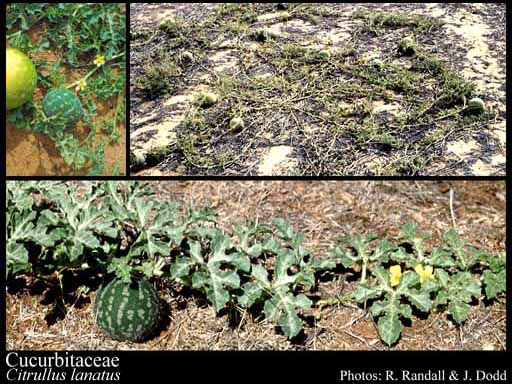- Reference
- Gen.Pl. [Jussieu] 393 (1789)
- Name Status
- Current

Scientific Description
Common name. Cucumber Family.
Habit and leaf form. Herbaceous climbers (mostly more or less scandent, juicy), or herbs, or shrubs (rarely). Annual, or perennial; plants with neither basal nor terminal concentrations of leaves; perennials in temperate regions tuberous. Climbing (mostly, or more or less trailing), or self supporting; tendril climbers (often, the tendrils representing modified shoots or stipules, usually one per node), or scrambling (the tendrils occasionally reduced to spines). Mesophytic to xerophytic. Leaves alternate; spiral; petiolate; non-sheathing; simple, or compound; when compound ternate, or palmate. Leaf blades dissected, or entire; when simple/dissected, palmately lobed; usually palmately veined; cross-venulate. Leaves without stipules (but tendrils may represent these); without a persistent basal meristem. Leaf anatomy. Hydathodes very commonly present. Extra-floral nectaries often present. Stem anatomy. Nodes tri-lacunar. Secondary thickening developing from a conventional cambial ring, or anomalous; via concentric cambia (commonly), or from a single cambial ring.
Reproductive type, pollination. Fertile flowers functionally male and functionally female, or functionally male, or functionally female, or hermaphrodite, functionally male, and functionally female. Unisexual flowers present, or absent (rarely). Plants monoecious (commonly), or dioecious (commonly), or polygamomonoecious, or hermaphrodite (rarely). Entomophilous.
Inflorescence and flower features. Flowers solitary, or aggregated in ‘inflorescences’. Inflorescences axillary. Flowers small to large; regular (usually), or somewhat irregular. The floral asymmetry most noticeably involving the androecium. Flowers cyclic; tetracyclic. Free hypanthium present. Perianth with distinct calyx and corolla; (6–)10(–12); 2 -whorled; isomerous. Calyx (3–)5(–6); 1 -whorled; gamosepalous; imbricate, or open in bud; regular. Corolla (3–)5(–6); 1 -whorled; polypetalous, or gamopetalous; more or less valvate; regular; green, or white, or yellow, or orange. Fertile stamens present, or absent (from female flowers). Androecium 5 (‘essentially’), or 3 (ostensibly, by reduction and displacement). Androecial members branched and unbranched (commonly there are three stamens, two bifurcated and with two pairs of pollen sacs each, the other unbranched and conventional with two pollen sacs), or unbranched; usually adnate (to the hypanthium); variously coherent (by connate filaments, or in Cucurbita by cohesion of the anthers into a column), or free of one another; when coherent, commonly 1 - adelphous (i.e. all the stamens joined in a central column), or 2 - adelphous (4/1 in Thladiantha); 1 -whorled. Androecium exclusively of fertile stamens. Stamens 3, or 5; reduced in number relative to the adjacent perianth, or isomerous with the perianth. Anthers cohering (commonly), or connivent, or separate from one another; adnate; dehiscing via longitudinal slits; extrorse; unilocular, or unilocular and bilocular (often one unilocular, the others bilocular), or bilocular; bisporangiate, or bisporangiate and tetrasporangiate, or tetrasporangiate; appendaged (via the prolonged connective), or unappendaged. Fertile gynoecium present, or absent (from male flowers). Gynoecium 1 carpelled (Cyclanthereae), or (2–)3(–5) carpelled. The pistil 1 celled, or 2–3(–5) celled. Carpels reduced in number relative to the perianth. Gynoecium monomerous, or syncarpous; of one carpel (Cyclanthereae), or synovarious, or synstylovarious, or eu-syncarpous; inferior. Ovary unilocular to plurilocular; 1 locular, or 2–3(–5) locular (by joining of the usually intruded parietal placentae). Locules secondarily divided by ‘false septa’, or without ‘false septa’. Gynoecium stylate. Styles partially joined; apical. Stigmas commissural; each 2 - lobed (in association with the commissural position, suggestive of derivation from adjacent carpels), or 3 - lobed (rarely?); wet type, or dry type; papillate, or non-papillate; Group II type and Group III type. Placentation parietal (usually); when the ovary plurilocular, axile. Ovules in the single cavity when unilocular, (1–)3–100 (i.e. to ‘many’); when plurilocular (1–)3–50 per locule; pendulous, or horizontal, or ascending; non-arillate; anatropous.
Fruit and seed features. Fruit fleshy (usually), or non-fleshy (sometimes); dehiscent (sometimes explosively so), or indehiscent; a berry (usually, most commonly in the form of a ‘gourd’ (pepo) or an amphisarca), or a capsule, or a samara (rarely). Seeds non-endospermic; medium sized to large; often flattened, winged, or wingless. Cotyledons 2 (large, flat). Embryo achlorophyllous (9/11); straight. Seedling. Germination phanerocotylar, or cryptocotylar.
Physiology, biochemistry. Aluminium accumulation not found. Photosynthetic pathway: C3 and CAM.
Geography, cytology, number of species. World distribution: wanting only in colder regions. X = 7–14. 640 species.
Economic uses, etc. Many sources of important edible fruits, e.g. Cucurbita, Cucumis, Lagenaria, Sechium (melons, cucumbers, etc.), and some are poisonous.